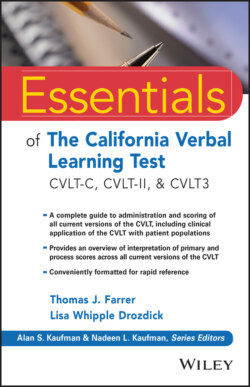Читать книгу Essentials of the California Verbal Learning Test - Thomas J. Farrer - Страница 14
Rapid Reference 1.4 Changes from CVLT-II to CVLT3
ОглавлениеNew normative sample reflective of 2015 U.S. Census data
Increased age range to 90
Index scores on standard score metric (mean = 100, SD = 15)
Primary scores on scaled score metric (mean = 10, SD = 3)
Trials 1–5 Total score computed by summing scaled scores for Trials 1–5
Norms provided are age corrected only
Demographic adjustments to normative scores available for sex and education, presented as T scores
Forced-choice recognition items modified to include only concrete distractors (abstract distractors were removed)
New measures of across- and within-trial intrusions
New measures of intrusion error types
New yes/no recognition scores that describe the types of recognition errors
The CVLT3 introduced significant changes to the scoring of the CVLT-II. Although scores still measure the processes underlying attention, learning, and memory, the traditional T score and z-score metrics were changed to standard and scaled scores. This allows direct comparison to other measures commonly used in evaluations. Three index scores are derived by summing the scaled scores for the learning trials (Trials 1–5), for the delayed recall trials (free and cued recall), and for all recall trials (learning, interference, short delay, and long delay). For the primary process scores, age-corrected scaled scores were derived with a mean of 10 and a standard deviation of 3. In addition, cumulative percentages are provided for some scores that had highly skewed distributions. The normative scores derived in CVLT3 are listed in Rapid Reference 1.5 by condition.
Contrast scores are utilized for difference scores in CVLT3. Contrast scaled scores provide information about performance on one task adjusted for performance on another relevant task. Similar to the manner in which demographic adjustments are derived for normative scores, one score is adjusted to account for performance on a related but separate score. For example, the Long-Delay Free-Recall Correct vs. Short-Delay Free-Recall Correct Contrast Scaled Score adjusts the long-delay score based on performance on short-delay recall. This accounts for differences in performance on delayed memory due to differences in immediate recall. The new score represents the examinee's performance on delayed memory in comparison to individuals of similar immediate memory ability. Because contrast scores utilize age-adjusted scaled scores, they are not further adjusted by age. Contrast scaled scores are provided at the scaled score level and are presented as scaled scores with a mean of 10 and a standard deviation of 3. Contrast scores are used to interpret scores in relation to similar ability peers; they do not replace subtest scaled scores and should not be substituted for primary scores in reports or to compute index scores. Detailed information on the interpretation of contrast scaled scores is provided in Chapter 4.
The CVLT3 introduces the use of demographic adjustments to norms. In addition to the age-adjusted normative scores, education, and sex adjustments are provided in the scoring software. The demographic adjustments are applied to the normative scores to produce T scores that account for education and sex differences.
